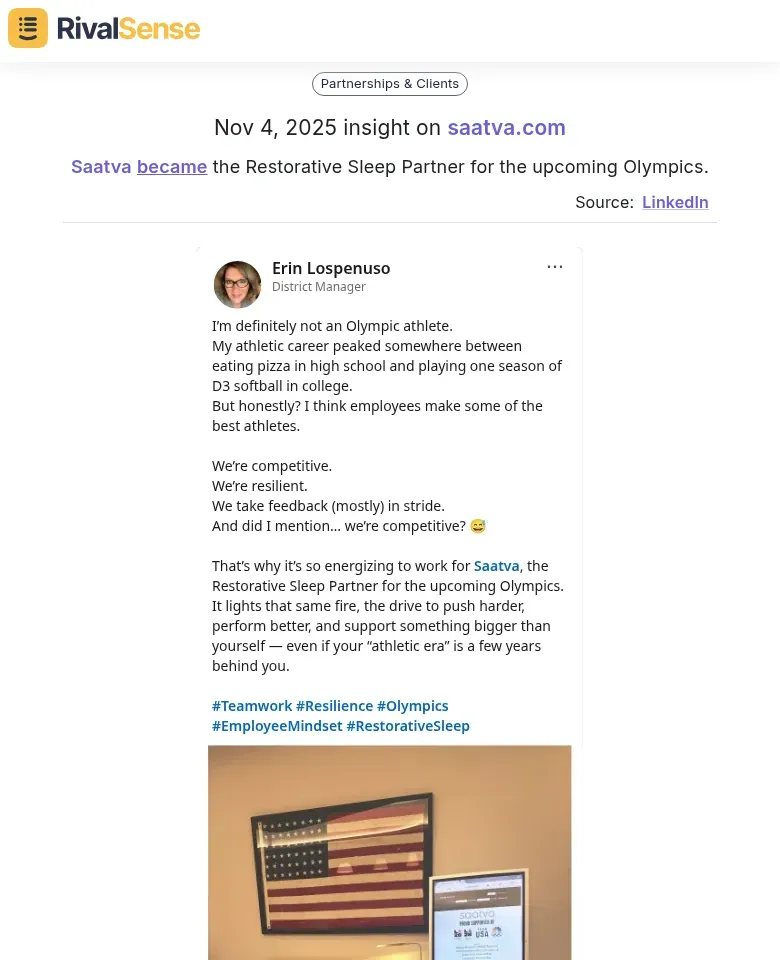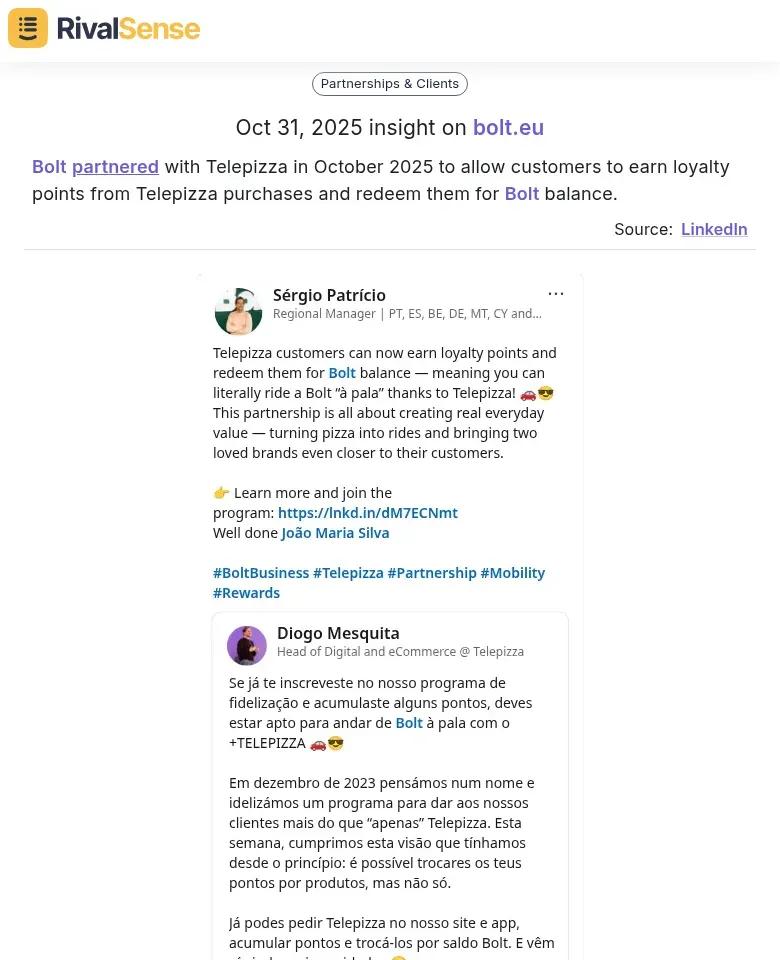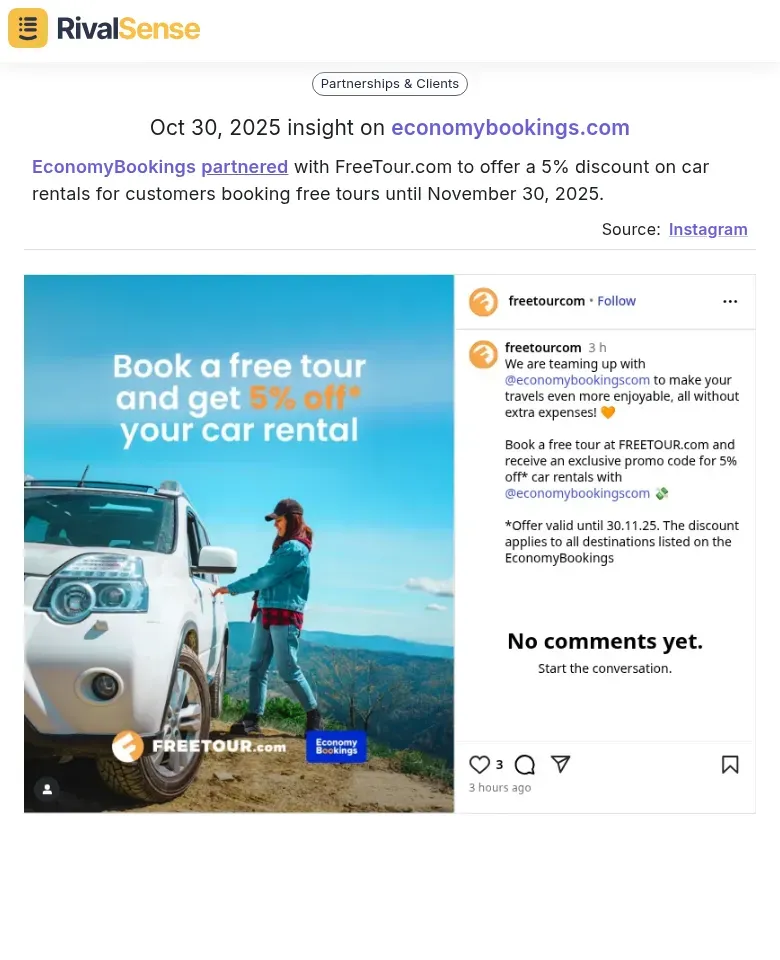Competitor Partnership Tracking Framework: Uncover Promotional Insights
Competitor partnership tracking is the systematic monitoring of alliances, collaborations, and joint ventures between your rivals and other entities. In competitive intelligence, it serves as a radar for strategic shifts—revealing market trends like industry consolidation or entry into new segments. For example, if a competitor partners with a tech firm, it may signal a pivot to digital transformation. Tracking these moves uncovers promotional insights: co-branded campaigns, referral programs, or bundled offerings that boost brand visibility and customer acquisition. Practical steps include:
✅ Identify key competitors and their typical partners (e.g., suppliers, influencers).
✅ Use tools like social media alerts and news aggregators to monitor announcements.
✅ Analyze partnership terms—duration, exclusivity—to gauge commitment.
✅ Assess impact through metrics like shared audience reach or sales spikes.
This framework helps you anticipate threats, spot opportunities, and refine your own partnership strategies for competitive advantage.
Key Types of Competitor Partnerships to Monitor
Tracking competitor partnerships reveals strategic moves and growth opportunities. Focus on these key types to stay ahead in your market.
Co-branding & Sponsorship Deals: Monitor collaborations where brands align for mutual benefit—like a tech firm sponsoring an industry event or co-creating products. This boosts brand visibility and credibility. Example: Saatva became the Restorative Sleep Partner for the upcoming Olympics.  This type of partnership can enhance brand credibility and tap into new audiences, providing insights into leveraging high-profile events for strategic growth. Tip: Use social media and press releases to spot these deals; assess if they target your audience segments.
This type of partnership can enhance brand credibility and tap into new audiences, providing insights into leveraging high-profile events for strategic growth. Tip: Use social media and press releases to spot these deals; assess if they target your audience segments.
Loyalty & Rewards Integrations: Watch for partnerships that embed loyalty programs (e.g., a SaaS tool integrating with a popular rewards platform). This enhances customer retention by adding value. Example: Bolt partnered with Telepizza in October 2025 to allow customers to earn loyalty points from Telepizza purchases and redeem them for Bolt balance.  Tracking such integrations helps understand how to improve customer loyalty and drive cross-promotional opportunities, offering actionable ideas for your own retention strategies. Checklist:
Tracking such integrations helps understand how to improve customer loyalty and drive cross-promotional opportunities, offering actionable ideas for your own retention strategies. Checklist:
✅ Note the partners involved and reward structures.
✅ Analyze how they reduce churn and boost engagement.
✅ Consider if you can match or counter with better incentives.
Cross-Promotional Discounts: Identify joint offers, like bundled discounts between complementary services, to attract new customer segments and drive sales. Example: EconomyBookings partnered with FreeTour.com to offer a 5% discount on car rentals for customers booking free tours until November 30, 2025.  This reveals tactics for creating urgency and expanding reach, helping you design effective limited-time promotions that resonate with your target market. Practical Step: Set up alerts for discount codes and analyze their duration and impact; test similar promotions to gauge effectiveness.
This reveals tactics for creating urgency and expanding reach, helping you design effective limited-time promotions that resonate with your target market. Practical Step: Set up alerts for discount codes and analyze their duration and impact; test similar promotions to gauge effectiveness.
By systematically tracking these partnerships, you gain insights into competitor strategies, uncover gaps in your own approach, and identify potential partnership opportunities to stay competitive.
Framework for Tracking and Analyzing Partnerships
A systematic framework for tracking competitor partnerships reveals strategic insights and keeps you proactive. Start by setting up real-time monitoring using tools like RivalSense to track announcements, press releases, and social media for immediate alerts, ensuring you catch new alliances as they form. Next, analyze each partnership's objectives—are they aiming for market expansion, product enhancement, or customer acquisition? Identify the target audiences and mutual benefits; for example, a SaaS company partnering with a consultancy might target enterprise clients, sharing leads and expertise.
Evaluate performance metrics: monitor engagement rates on co-branded content, conversion lifts from joint webinars, and shifts in market share using industry reports. Practical steps:
✅ Create a checklist to log partnership details (e.g., partners, goals, timelines).
✅ Set up Google Alerts for competitor names plus 'partnership' or 'collaboration.'
✅ Review quarterly performance dashboards to track trends.
Tip: Focus on partnerships that overlap with your ideal customer profile to anticipate competitive moves and identify collaboration opportunities for your business.
Extracting Strategic Insights from Partnership Examples
Partnerships reveal strategic expansion plays and offer lessons for your own growth. Track competitors' collaborations to see how they enter new markets or demographics, and analyze the underlying tactics. For example, a B2B SaaS firm partnering with a regional distributor gains local footholds, highlighting opportunities for geographic diversification. Analyze deal structures: joint ventures, co-marketing, or reseller agreements to understand commitment levels and resource allocation.
Use a checklist to systematize insights:
✅ Identify partner types (complementary vs. adjacent).
✅ Assess geographic or demographic reach and alignment with your goals.
✅ Monitor announcement frequency to gauge strategic urgency.
Loyalty programs benefit from partnerships—observe how competitors integrate partners to add value and reduce churn. A retail brand might team with a travel company for cross-rewards, boosting retention. Steps: map partner ecosystems, evaluate reward synergies, and test customer engagement metrics. Limited-time offers (LTOs) create urgency; partnerships amplify this. Note tactics like exclusive bundle deals or flash sales with partners. Tips: Set up alerts for partnership launches, analyze promo durations, and measure sales spikes to refine your own promotional strategies.
Implementing Insights into Your Business Strategy
Once you've gathered competitive partnership data, apply it strategically to drive your business forward. First, identify partnership opportunities with complementary brands by analyzing competitor collaborations—look for gaps where your offerings can fill customer needs and enhance value propositions. For example, if a rival partners with a logistics firm, consider teaming up with a payment provider to streamline operations and attract similar segments. Second, adapt successful partnership models: study what works (e.g., co-branded campaigns, joint webinars) and tailor them to your audience, ensuring alignment with your brand values and goals.
Third, use this data to anticipate market moves; track trends like new alliances to refine your strategic planning and stay ahead of shifts. Practical steps include:
✅ Create a checklist to evaluate potential partners based on shared goals and audience overlap.
✅ Set up alerts for competitor announcements to stay updated.
✅ Regularly review partnership performance metrics to iterate and improve.
Tips: Focus on partnerships that boost customer retention, test small-scale collaborations first to minimize risk, and leverage real-time insights for data-driven decisions that keep you competitive.
Take Action with RivalSense
Now that you have a framework for tracking and leveraging competitor partnerships, put it into practice with RivalSense. Our tool automatically monitors competitor product launches, pricing updates, event participations, partnerships, regulatory changes, management shifts, and media mentions, delivering concise weekly email reports. Try RivalSense for free at https://rivalsense.co/ and get your first competitor report today to start uncovering actionable insights for your business strategy!
📚 Read more
👉 How to Analyze Competitor Promotions for Strategic Advantage
👉 Key Account Management Software: The Ultimate Guide for 2026
👉 Data-Driven Key Account Tracking for Healthcare IT: A Strategic Guide to Patient Management
👉 How Vanta's NBA Partnership Revealed Key Expansion Strategy
👉 Optimize Competitor Insights from Website Changes for Strategic Advantage
